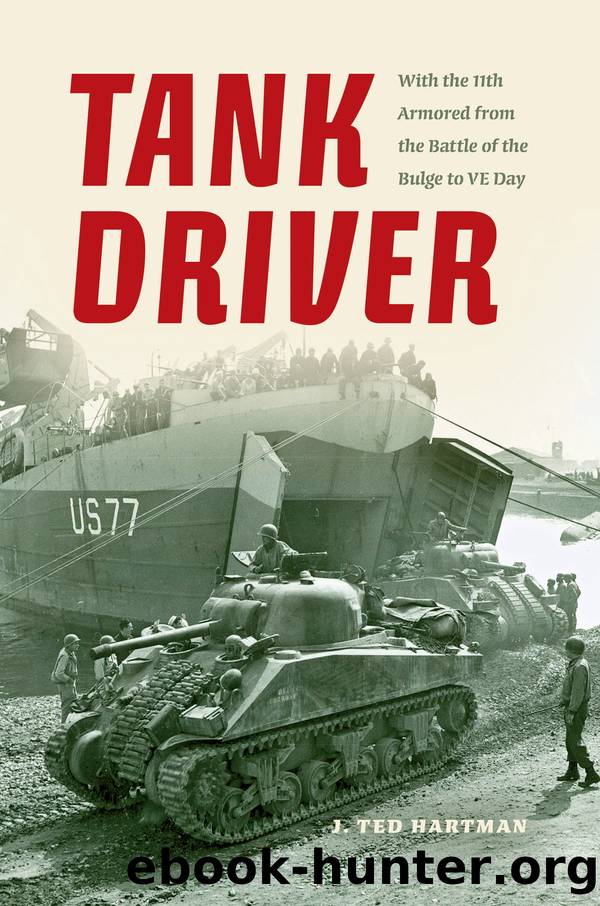Tank Driver by J. Ted Hartman

Author:J. Ted Hartman
Language: eng
Format: epub
Publisher: Indiana University Press
Published: 2014-09-14T16:00:00+00:00
Concrete obstacles in the Siegfried Line prevent tank passage, requiring infantry and other ground troops to clear. U.S. Army, Thunderbolts in the ETO.
A classic battle plan of action usually called for an initial barrage of artillery fire prior to a ground attack. Since this was the expected plan of attack, the German defenders in the Siegfried Line bunkers anticipated such a barrage, so they were taken by complete surprise when our infantry jumped off before dawn on February 18th without an artillery bombardment. This successful attack allowed the infantry to gain control of a pathway through the Siegfried Line. The field artillery then dropped round after round of explosives on the concrete barriers to break them up. This was followed by bulldozers that came in and pushed the concrete boulders out of the way, which created a passageway for the tanks to move through and begin an attack.
Even with this good beginning, it took several weeks to clear the way for tanks to pass through so we could begin a major drive into Germany. Several villages were an integral part of the Siegfried Line, so our infantry had to take control of them also. It was the end of February before the entire division could begin to move again.
The weather was getting warmer, and melting snow left muddy roads everywhere. Those of us from tank battalions were sent out on detail to work on the roads. We were laying small logs across the roads to make them passable. It was here, while we were working on the roads, that General Patton was driven by almost daily. He was a picture, standing in front of the right seat of his jeep. His left hand held onto a special handle that had been welded onto the wind-shield frame, his right hand free to salute. He obviously expected us to drop our shovels and salute him, so, of course, we did.
These several weeks in Binsfeld had given us a chance to perform maintenance on our tanks, which were in the motor park in a field just outside of town. We marched there each morning, worked on our tanks, and returned to the village for lunch. Then we went back to the motor park in the afternoon and worked several more hours. There were so many things that needed ongoing attention on a tank.
At Camp Cooke, we had been taught how to care for the submachine gun and given lessons for using and firing it. In England, each member of a tank crew was given a submachine gun with the instruction that we were not to be outside our tank without carrying it. This order was reinforced when we joined Patton’s Third Army at Soissons.
One afternoon just as we had completed work at the motor park, several of us began playing cowboys and Indians. We were running around the field chasing each other, when all of a sudden, one of our submachine guns fired. No one was injured, but it frightened us and sobered us very quickly.
Download
This site does not store any files on its server. We only index and link to content provided by other sites. Please contact the content providers to delete copyright contents if any and email us, we'll remove relevant links or contents immediately.
Blood and Oil by Bradley Hope(1531)
Wandering in Strange Lands by Morgan Jerkins(1375)
Ambition and Desire: The Dangerous Life of Josephine Bonaparte by Kate Williams(1347)
Daniel Holmes: A Memoir From Malta's Prison: From a cage, on a rock, in a puddle... by Daniel Holmes(1295)
It Was All a Lie by Stuart Stevens;(1265)
Twelve Caesars by Mary Beard(1258)
The First Conspiracy by Brad Meltzer & Josh Mensch(1141)
What Really Happened: The Death of Hitler by Robert J. Hutchinson(1131)
London in the Twentieth Century by Jerry White(1114)
Time of the Magicians by Wolfram Eilenberger(1091)
Twilight of the Gods by Ian W. Toll(1086)
The Japanese by Christopher Harding(1086)
Cleopatra by Alberto Angela(1063)
A Woman by Sibilla Aleramo(1055)
Lenin: A Biography by Robert Service(1046)
The Devil You Know by Charles M. Blow(987)
Reading for Life by Philip Davis(974)
The Life of William Faulkner by Carl Rollyson(926)
1965--The Most Revolutionary Year in Music by Andrew Grant Jackson(925)
